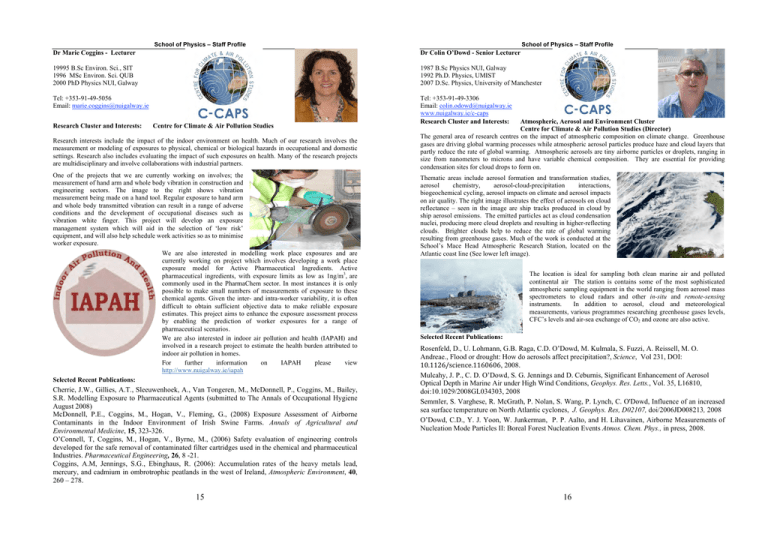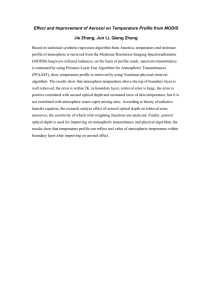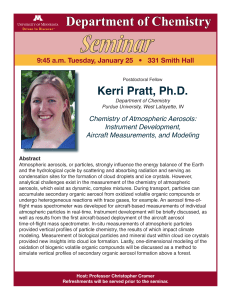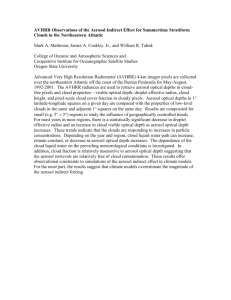Dr Marie Coggins - Lecturer 19995 B.Sc Environ. Sci., SIT
advertisement

School of Physics – Staff Profile School of Physics – Staff Profile Dr Marie Coggins - Lecturer Dr Colin O’Dowd - Senior Lecturer 19995 B.Sc Environ. Sci., SIT 1996 MSc Environ. Sci. QUB 2000 PhD Physics NUI, Galway 1987 B.Sc Physics NUI, Galway 1992 Ph.D. Physics, UMIST 2007 D.Sc. Physics, University of Manchester Tel: +353-91-49-5056 Email: marie.coggins@nuigalway.ie Tel: +353-91-49-3306 Email: colin.odowd@nuigalway.ie www.nuigalway.ie/c-caps Research Cluster and Interests: Research Cluster and Interests: Centre for Climate & Air Pollution Studies Research interests include the impact of the indoor environment on health. Much of our research involves the measurement or modeling of exposures to physical, chemical or biological hazards in occupational and domestic settings. Research also includes evaluating the impact of such exposures on health. Many of the research projects are multidisciplinary and involve collaborations with industrial partners. One of the projects that we are currently working on involves; the measurement of hand arm and whole body vibration in construction and engineering sectors. The image to the right shows vibration measurement being made on a hand tool. Regular exposure to hand arm and whole body transmitted vibration can result in a range of adverse conditions and the development of occupational diseases such as vibration white finger. This project will develop an exposure management system which will aid in the selection of ‘low risk’ equipment, and will also help schedule work activities so as to minimise worker exposure. We are also interested in modelling work place exposures and are currently working on project which involves developing a work place exposure model for Active Pharmaceutical Ingredients. Active pharmaceutical ingredients, with exposure limits as low as 1ng/m3, are commonly used in the PharmaChem sector. In most instances it is only possible to make small numbers of measurements of exposure to these chemical agents. Given the inter- and intra-worker variability, it is often difficult to obtain sufficient objective data to make reliable exposure estimates. This project aims to enhance the exposure assessment process by enabling the prediction of worker exposures for a range of pharmaceutical scenarios. We are also interested in indoor air pollution and health (IAPAH) and involved in a research project to estimate the health burden attributed to indoor air pollution in homes. For further information on IAPAH please view http://www.nuigalway.ie/iapah Selected Recent Publications: Cherrie, J.W., Gillies, A.T., Sleeuwenhoek, A., Van Tongeren, M., McDonnell, P., Coggins, M., Bailey, S.R. Modelling Exposure to Pharmaceutical Agents (submitted to The Annals of Occupational Hygiene August 2008) McDonnell, P.E., Coggins, M., Hogan, V., Fleming, G., (2008) Exposure Assessment of Airborne Contaminants in the Indoor Environment of Irish Swine Farms. Annals of Agricultural and Environmental Medicine, 15, 323-326. O’Connell, T, Coggins, M., Hogan, V., Byrne, M., (2006) Safety evaluation of engineering controls developed for the safe removal of contaminated filter cartridges used in the chemical and pharmaceutical Industries. Pharmaceutical Engineering, 26, 8 -21. Coggins, A.M, Jennings, S.G., Ebinghaus, R. (2006): Accumulation rates of the heavy metals lead, mercury, and cadmium in ombrotrophic peatlands in the west of Ireland, Atmospheric Environment, 40, 260 – 278. 15 Atmospheric, Aerosol and Environment Cluster Centre for Climate & Air Pollution Studies (Director) The general area of research centres on the impact of atmospheric composition on climate change. Greenhouse gases are driving global warming processes while atmospheric aerosol particles produce haze and cloud layers that partly reduce the rate of global warming. Atmospheric aerosols are tiny airborne particles or droplets, ranging in size from nanometers to microns and have variable chemical composition. They are essential for providing condensation sites for cloud drops to form on. Thematic areas include aerosol formation and transformation studies, aerosol chemistry, aerosol-cloud-precipitation interactions, biogeochemical cycling, aerosol impacts on climate and aerosol impacts on air quality. The right image illustrates the effect of aerosols on cloud reflectance – seen in the image are ship tracks produced in cloud by ship aerosol emissions. The emitted particles act as cloud condensation nuclei, producing more cloud droplets and resulting in higher-reflecting clouds. Brighter clouds help to reduce the rate of global warming resulting from greenhouse gases. Much of the work is conducted at the School’s Mace Head Atmospheric Research Station, located on the Atlantic coast line (See lower left image). The location is ideal for sampling both clean marine air and polluted continental air The station is contains some of the most sophisticated atmospheric sampling equipment in the world ranging from aerosol mass spectrometers to cloud radars and other in-situ and remote-sensing instruments. In addition to aerosol, cloud and meteorological measurements, various programmes researching greenhouse gases levels, CFC’s levels and air-sea exchange of CO2 and ozone are also active. Selected Recent Publications: Rosenfeld, D., U. Lohmann, G.B. Raga, C.D. O’Dowd, M. Kulmala, S. Fuzzi, A. Reissell, M. O. Andreae., Flood or drought: How do aerosols affect precipitation?, Science, Vol 231, DOI: "#$""%&'()*+,)+$""&#&#&, 2008.! Mulcahy, J. P., C. D. O’Dowd, S. G. Jennings and D. Ceburnis, Significant Enhancement of Aerosol Optical Depth in Marine Air under High Wind Conditions, Geophys. Res. Letts., Vol. 35, L16810, doi:10.1029/2008GL034303, 2008! Semmler, S. Varghese, R. McGrath, P. Nolan, S. Wang, P. Lynch, C. O'Dowd, Influence of an increased sea surface temperature on North Atlantic cyclones, J. Geophys. Res, D02107, doi/2006JD008213, 2008 O’Dowd, C.D., Y. J. Yoon, W. Junkerman, P. P. Aalto, and H. Lihavainen, Airborne Measurements of Nucleation Mode Particles II: Boreal Forest Nucleation Events Atmos. Chem. Phys., in press, 2008. 16






